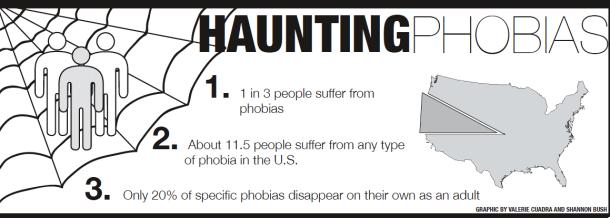Hexakosioihexekontahexa-phobia- the fear of the number 666. Albuminurophobia- the fear of kidney disease. Consecotaleophobia- the fear of chopsticks. Apparently, a name exists for almost every fear imaginable. But how does one define a phobia? What do the signs and symptoms consist of? How do phobias affect one’s daily lifestyle?
Phobias fall under the “anxiety disorders” category. An extreme and irrational fear of a simple object or specific social situation in which no present threat actually subsists characterizes a phobia. Essentially, they are a “fear of a fear.”
Among the hundreds of thousands of phobias that exist, some of the more common ones include: erythrophobia (fear of blushing), aerophobia (fear of flying), acrophobia (fear of heights), and arachnophobia (fear of spiders). However, nyctohylophobia (the fear of dark water), possessed by junior Natalie Friedman, is relatively rare.
From lakes to pools, classes involving water to oceans, Friedman fears all forms of water. Friedman claims she cannot go anywhere near, let alone think of, deep water, for it triggers undesired emotions that make her feel uncomfortable.
“My fear of dark water has gotten so bad that I can’t even go into the deep end of my pool. I really wanted to take Marine Biology this year too, but I knew I couldn’t,” Friedman said. “The idea of deep water just makes me feel really scared. I get the chills.”
Phobias seem to originate in genetically-predisposed individuals who have undergone a traumatic experience. Brain scans illustrate that when individuals experience a phobia, their prefrontal lobe of the brain dramatically increases with activity. Physiologically, when people become exposed to a phobia, they may experience an increase in sweating, heart rate and adrenaline blood concentration.
Nonetheless, people who claim to have a “phobia” occasionally misuse the term to identify a simple, rational fear.
“Not all fears are phobias,” AP Psychology teacher Dr. Amy Schaeffer said. “If you have so much anxiety and distress built up inside of you that it inhibits your daily tasks, then it might be a phobia.”
Phobias are indisputably an integral part of society. Many talk shows, essays, magazine articles and novels have extreme, irrational fears as a major theme or central topic. “Maury Television,” a show consisting of individuals exposed to their fear, illustrates how phobias curtail enjoyment of life and how psychological techniques such as flooding can help rid one of irrational fears.
The nationally-acclaimed BBC News organization has written articles on phobias, to which people responded with their own personal fears and how they overcame them in the form of a blog.
Psychologists use countless ways to help clients overcome their phobias. In systematic desensitization, psychologists lead people possessing the phobias through a series of exposures, eventually riding them of the irrational fear. In the controversial technique of flooding, psychologists abruptly expose the individual to the feared object or situation until the fear ceases.
Unfortunately for thanatophobics (people fearing an end), this article can only persist for so long.








